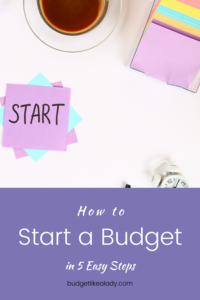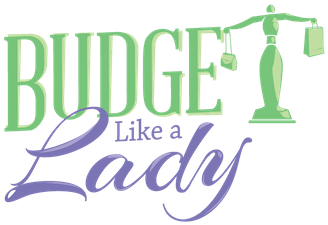How to Start a Budget in 5 Easy Steps

5 Money Moves to Make to Prepare for a Recession
June 2, 2020
Top 3 Reasons Why Every Budgeter Needs a Tracking System
September 29, 2020You hear about it all the time. Budgets. You know you need one and at one point you had one, but it just seems too hard to make one and keep up with it.
Creating a budget sounds like a complicated process but it doesn’t have to be. What if you could have a budget by the end of this post? What if there were only 5 steps to creating a simple budget that will start you on your journey to financial stability?

I want to share with you the same 5 steps I share with my clients who are beginner budgeters. Grab a pen and paper, or an excel spreadsheet if you like, and let’s get started!
Step 1: Defining what a budget is
The definition of a budget is a money plan where you balance your income and your expenses. Although this is the informal definition of a budget, what does HAVING a budget mean to you? If you have a budget, how will you feel? Will you feel more secure in your financial decisions? Will you feel less overwhelmed about your money?
Defining what a budget is and what it means to you is the key to starting a budget. Your definition of a budget may not be the same as mine and it doesn’t have to be. Your definition is just for YOU.
Step 2: Pick a Budgeting Method
Often when a budget fails, it means you picked the wrong budgeting method. Budgeting is about you and what works for you, not just financially but methodically. Choosing a budgeting method can free you from feeling like a failure. Remember, if one budgeting method doesn’t work, try another one!
The most common budgeting methods are:
The Anti-Budget. Yes, there is such a thing as a non-budget. This budget method is the simplest budget. You spend 80% of your income while saving, or paying off debt, with the other 20%. This method lets you save money and/or pay off debt while not having to track every dollar. If you are new to budgeting or if budgeting scares you too much, I suggest giving the anti-budget a try.
50/30/20 Budget. This budget breaks down your expenses into 3 simple categories: needs, wants, and savings/debt. Your “needs” category will include the things you need to live such as housing, food (groceries), transportation, etc. Your “wants” category will include things you want but don’t need to live such as cable, dining out, gym memberships, etc. The last category is savings/debt which includes extra debt payoff, rainy day fund, vacations, etc.
Zero-Based Budget. This budget method gives every dollar a job. This method has more categories and subcategories than the anti-budget and the 50/30/20 budget. There will be no “leftover” money with a zero-based budget. You will budget all of your income to zero which means all the money you have coming in WILL be spent or saved. If you are new to budgeting and the thought of giving every dollar a job seems overwhelming, choose a different budgeting method.
Cash-Only Budget. This budget method can be combined with any of the above methods. Using the cash-only budget method will help you stop overspending. If you are finding that you are consistently going over budget, this cash method may be the method for you. When your cash runs out, you are done until the next payday.
Step 3: Pick Your Categories and Subcategories
Now that you have a budget method, this step should be a little easier. Picking your categories and subcategories are based on your budgeting method and current expenses. For example, if you are using the 50/30/20 Budget method, your categories will be Needs, Wants, and Savings/Debt, and your subcategories will be your current expenses.
To get an accurate list of your current expenses, I recommend you print last month’s banking statements and see what was deducted from your accounts. This will also shine some light on what subscriptions and memberships you are still paying for that you may not be using anymore.
Step 4: Set Your Budget Amounts
You made it to step 4! You picked a budget method and created categories and subcategories, now it is time to add your estimated amounts to every subcategory you created. Some expenses are easy to add to your budget such as your fixed expenses (rent/mortgage, cable/streaming, phone bill, etc.) while other expenses can be difficult to estimate, those are variable expenses.
If you are new to budgeting, use last month’s banking statements to get the best estimates. This includes adding up all variable expenses such as groceries, dining out, gas (fuel), entertainment, etc. When you have your amounts, remember that this is just your FIRST budget and it doesn’t need to be perfect.
Step 5: Track Your Income and Expenses, Monthly
Now that you have created a budget, it is time to see how you did! Tracking your income and expenses will let you know what changes you need to make to your budget. Take time weekly to track expenses. You can track your expenses with pen and paper which can be found in THE VAULT, excel spreadsheet, google sheet, or budgeting software. Pick a tracking system that makes YOU feel comfortable.
If you see that you overspent in some categories this month, make some changes to those categories next month. Your budget will always change and evolve as time goes on. You are learning to adapt to the budgeting process.
Now that you have created a budget, how did you feel? Are you excited for what’s to come?

